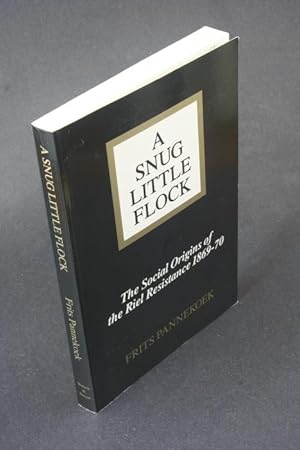Pannekoek Frits 1949 (1 results)
Product Type
- All Product Types
- Books (1)
- Magazines & Periodicals
- Comics
- Sheet Music
- Art, Prints & Posters
- Photographs
- Maps
-
Manuscripts &
Paper Collectibles
Condition
- All Conditions
- New
- Used
Binding
- All Bindings
- Hardcover
- Softcover
Collectible Attributes
- First Edition
- Signed
- Dust Jacket
- Seller-Supplied Images
- Not Printed On Demand
Seller Location
Seller Rating
-
A snug little flock: the social origins of the Riel resistance of 1869-70.
Published by Winnipeg, Manitoba: Watson & Dwyer, 1991, 1991
Seller: Steven Wolfe Books, Newton Centre, MA, U.S.A.
Pannekoek, Frits, 1949-. A snug little flock: the social origins of the Riel resistance of 1869-70. Winnipeg, Manitoba: Watson & Dwyer, 1991, vii, 276pp., PAPERBACK, very good. Discusses the Red River setting and the formation of the Métis identity in Canada. - CONTENTS: The Red River setting -- A question of leadership -- The first years -- A little Britain in the wilderness -- Free trade and social fragmentation -- A strife of blood -- The Rev. G. O. Corbett and an uprising of the people -- Halfbreeds and the Riel protest -- The Metis and the Riel protest. - COVER TEXT: Red River, in the 1830s, was a mix of Scottish farmers, Indians, fur traders, mixed-bloods of Scottish-Indian origin and Métis of French-In-dian origin. The colony was a challenge to missionaries who set out to create an English rural parish at the forks of the Red and Assiniboine. They believed and taught that indolence - the unchristian nomadic lifestyle of the buffalo hunt - must be replaced by the work of die Lord: agriculture. The traditional fur-trade marriage must be replaced by the Christian marriage which, they insisted, was the parent not the child of civil society ; the Christian marriage, however, could never correct the disastrous dilution of die Britannic race by Indian blood. In the strife of blood that followed, Red River became a society in which White looked down on mixed-blood, Catholic suspected Protestant, Halfbreed distrusted Métis and clergy opposed the officers of the Hudson s Bay Company. The end result was the civil war of 1869. Why did the Halfbreeds of Scottish and English origin submerge themselves in the 1860s among the white settlers or in the native community? Why are they excluded from a national identity? What factors formed the strong Métis identity? What are the implications of the way the Métis identity emerged from Métis claims to rectify past injustices and settle aboriginal cultural and land claims? This original and provocative book provides some of the answers. 9780920486504 ISBN 0920486509.


